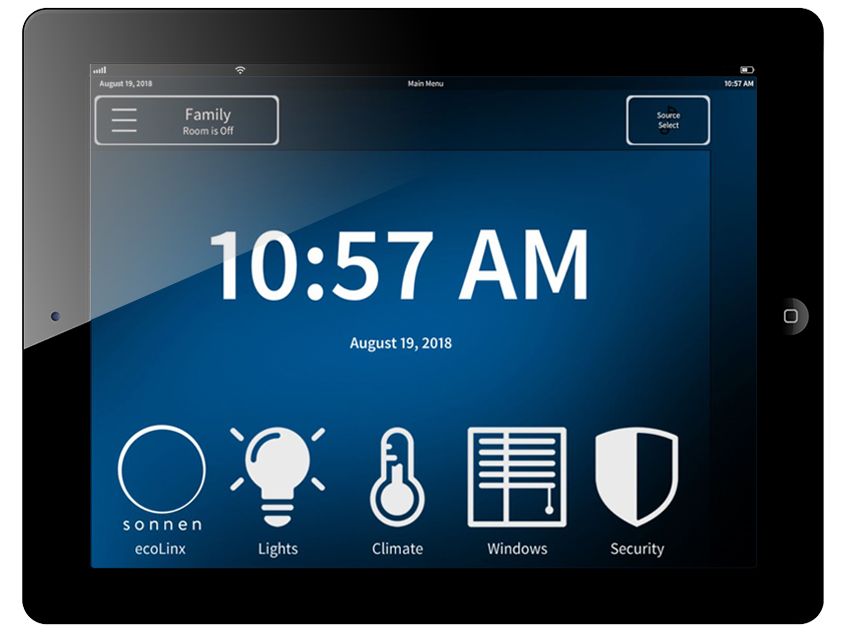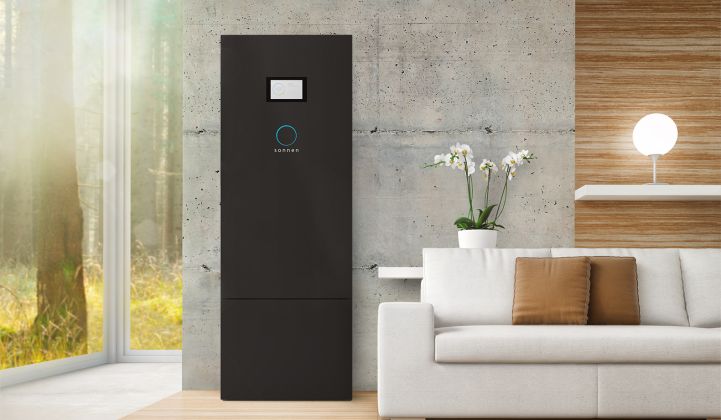When they go low, sonnen goes high.
Instead of striving to cut prices and make its product more accessible to the mass market, the U.S. branch of the German home battery company just released a new model that costs $10,000 more than its predecessor for the same 10 kilowatt-hours of energy capacity.
With that price bump, the ecoLinx delivers a longer battery life — warrantied for 15 years and 15,000 cycles. It also kicks on backup power much more quickly when the grid goes down — 100 milliseconds, instead of 30 seconds.
More alluringly, the ecoLinx comes fully integrated with two of the leading platforms in luxury home automation, which means the battery can interface with all the other smart appliances consuming energy in the home.
This goes much deeper than the Alexa or Google Home interface that many consumers think of as the frontier of the smart home. Beyond simply telling jokes and describing the weather, high-end home automation syncs up lights, security, audio, video and lampshades into a controllable, often highly customized system. Sonnen extends that reach to the battery and solar generation.
In unabashedly embracing the premium market, sonnen distances itself from the consumer battery companies racing to match the Tesla Powerwall’s aggressive pricing. It also pivots to a market where the ample expense of its battery pales in comparison to six-figure designer home overhauls.
“We're looking at the value a lot more than the price, and trying to actually prove that all this stuff we're saying in the energy industry can work,” said Senior Vice President Blake Richetta, in an interview at the CEDIA Expo last week. “When you reposition something around value, it's amazing what can happen.”
Sonnen hopes to thrive in a land where economic returns don't much matter. If it can prove out the technology there, with the bells and whistles to turn an entire home into a controllable grid asset, it could eventually bring that product to the masses — if the luxury market can sustain the company until then.

Sonnen situates the ecoLinx as one device in a bustling ecosystem of networked home appliances.
A time to grow, a time to cut
The home energy storage industry has been obsessed with cutting prices, following the lead of Tesla’s Powerwall. The thinking goes that massive scale will allow further price reductions, which will enable a vast flourishing of batteries in houses. More gigafactories are just around the corner.
The industry would do well to make products accessible to more of the population. However, intense focus on margin compression doesn’t help produce the kind of innovative breakthroughs that storage vendors could use so early in the product development cycle.
That difficulty is compounded by the fact that battery vendors aren’t making money at rock-bottom prices. After setting the conversation around how cheap batteries could be, even Tesla, with its Gigafactory to supply it, had to jack its rates.
In contrast, Richetta said, sonnen will make money on each ecoLinx unit it sells.
Rather than copying the Powerwall strategy, as Mercedes-Benz did when it tried and failed to build an energy storage subsidiary, Richetta wants to run the Tesla vehicle playbook: work out the kinks at the luxury level, where customers don’t mind paying a premium, and bring the technology downmarket over time.
A whole new world
Sonnen’s gambit amounts to industrial arbitrage, bridging the chasm between the cleantech industry and the high-end home automation industry.
As such, the company debuted ecoLinx not at Solar Power International but at CEDIA, the conference of the Custom Electronics Design and Installation Association. There was approximately one energy journalist in attendance.
The expo hall lacked any solar panels or nifty racking devices and backsheets. Instead, it sparkled with mural-sized, multimillion-dollar screens playing 8K high-definition video and pro-grade speaker systems that blend imperceptibly into the wall.
The CEDIA integrators, as they are called, act as a concierge, guiding their affluent clients through a surprisingly vast array of smart lighting, security and audiovisual options. Besides installation and servicing, the integrators help with bespoke programming to make the devices do exactly what their owners desire. Small deals reach the tens of thousands of dollars; “ultra-custom” jobs frequently blow past $200,000.
All these systems rely on high quality power, but energy was almost entirely absent from the conversation. Most compounds or ranches or estates that can afford this stuff have backup generators to keep them humming in a blackout.
Sonnen is betting that some of those clients can be persuaded to add a clean, perhaps solar-assisted, battery.
Though more expensive than a generator, batteries run quietly and emissions-free, and don’t rely on refills of liquid fuel that may be inaccessible in a prolonged emergency. But the pitch relies heavily on the feel-good effect of taking control of one’s energy consumption and potentially helping out the grid at large.

A sample view of the Crestron home automation platform, where sonnen sits alongside lighting and temperature control. (Image credit: sonnen)
The company integrated ecoLinx with cutting-edge smart circuit breakers from Eaton, which provide granular data on all power consumption in the house. That technology enables dynamic load shedding: In a peak pricing period or a blackout, it can automatically identify nonessential loads and turn them off. That replaces a hard-wired, inflexible backup power architecture.
In the demonstration, the ecoLinx pings NOAA weather readings and reports that a storm is expected in the area. The battery then switches itself from daily cycling into backup mode, to charge up fully before a potential outage. It can even dim the lights and close the blinds to keep the house cool and reduce load in case the power goes out.
If the outage comes, the battery can shut off the Jacuzzi but keep lights and refrigerator humming. It informs the homeowner how many hours of power remain; the resident can toggle specific loads on or off as needed. When grid power reappears, the smart breakers can return all devices to their status quo state.
Importantly, sonnen is not trying to expand into lights and thermostats; it has made its battery compatible with two of the three major automation software systems, Crestron and Control4. The third leader, Savant, has its own affiliated energy company called Racepoint Energy, which specializes in nanogrids for CEDIA clientele.
Will it work?
In taking such an unusual step, sonnen carries the burden of proof for several salient questions.
One is whether the luxury market is big enough to sustain a thriving business. Richetta is confident that it is, and it's clear that sonnen has exceedingly few if any competitors at that price point.
Richetta also asserted that the granularity of the energy data and control provided by the smart breakers will make sonnen's fleet all the more valuable for utilities. Instead of calling on a network of batteries, utilities can use sonnen to access a much broader range of equipment for a "virtual power plant." The home's large appliances and HVAC systems become part of the package.
We lack data so far on how the value of that more sophisticated home power portfolio compares to a conventional solar-plus-storage system. Even the more humble virtual power plants are just beginning to materialize.
It also remains to be seen whether homeowners would allow a utility to toggle their AC based on summer peaks. The theory is that more insight into home energy behavior will create more value as utilities seek to network homes into grid assets.
And then there is price. Sonnen envisions an eventual entry into the mass market, once it proves out the concept at the premium level. But it's likely that new competition will be waiting for it when and if that happens.
At least one other company has tackled the nexus of batteries and home automation head on: ElectrIQ, a young Bay Area contender taking on the bigger names in home energy storage. The company's PowerPod integrates with more approachable brands in smart home: Alexa, Nest, ecobee, Juicebox, Philips Hue lighting.
The PowerPod also works with products from Lutron, the controllable lighting company with a large presence at CEDIA (and Richetta's former employer), and with smart breakers from Schneider Electric, Eaton's main competitor. But customers who don't want to invest in a pricey panel upgrade can achieve similar functionality with networked smart plugs, said ElectrIQ co-founder and CEO Chad Manning.
"Sonnen is betting that their customers will probably assume that the best product is also the most expensive," Manning said. "They are targeting a very niche market focused on customer home builds for the rich and famous. They'll never be able to compete in marketing this product to the masses because very few will be able to afford it."
The upshot there is that it is possible to deliver a home automation battery at a lower price point, if the customer is willing to use store-bought light bulbs or do a little configuration themselves. The CEDIA pros, on the other hand, sell to customers who want someone else to handle all the setup for them, and make it look beautiful and effortless.
There are many types of homeowners in the U.S., and if the residential battery market keeps growing as expected, the battery industry could reach several different niches. In the meantime, the industry can stop talking about energy automation as a futuristic ideal, because the technology is already entering homes.




